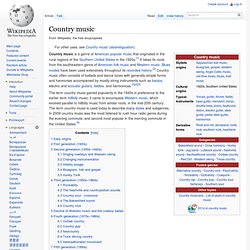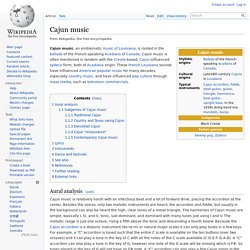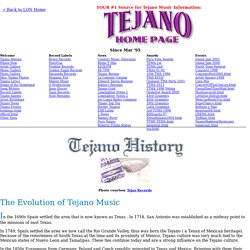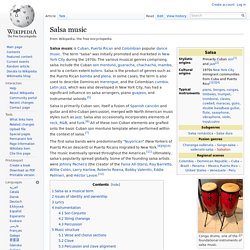

Country music. Early origins[edit] Ryman Auditorium, the "Mother Church of Country Music" Immigrants to the Southern Appalachian Mountains of North America brought the music and instruments of the Old World along with them for nearly 300 years.

They brought some of their most important valuables with them, and to most of them this was an instrument: "Early Irish settlers enjoyed the fiddle because it could be played to sound sad and mournful or bright and bouncy. "[7] The Irish fiddle, the German-derived dulcimer, the Italian mandolin, the Spanish guitar, and the West African banjo[8] were the most common musical instruments. According to historian Bill Malone in Country Music U.S.A, country music was "introduced to the world as a southern phenomenon "Country music is the combination of African and European folk songs coming together and doing a little waltz right here in the American south. Country music is often erroneously thought of as solely the creation of European Americans. Hillbilly boogie[edit] George Strait - "Give It All We Got Tonight" ((ACM Awards 2013))
Country Music Instruments. Cajun music. Cajun music, an emblematic music of Louisiana, is rooted in the ballads of the French-speaking Acadians of Canada.

Cajun music is often mentioned in tandem with the Creole-based, Cajun-influenced zydeco form, both of Acadiana origin. These French Louisiana sounds have influenced American popular music for many decades, especially country music, and have influenced pop culture through mass media, such as television commercials. Aural analysis[edit] Cajun music is relatively harsh with an infectious beat and a lot of forward drive, placing the accordion at the center. Cajun Music: The Savoy Family Band.
Cajun Musical Instruments. Tejano Music History. Photo courtesy Tejas Records The Evolution of Tejano Music In the 1690s Spain settled the area that is now known as Texas .

In 1718, San Antonio was established as a midway point to the missions of east Texas. In 1749, Spain settled the area we now call the Rio Grande Valley, thus was born the Tejano ( a Texan of Mexican heritage). Because of the remoteness of South Texas at the time and its proximity of Mexico, Tejano culture was very much tied to the Mexican states of Nuevo Leon and Tamalipas. In the 1850s Europeans from Germany, Poland and Czech republic migrated to Texas and Mexico. It was a rough life, but one of pride. With the accordion, drum and the bajo sexto, a 12 string bass guitar from Spain, Tejanos now had a sound they could begin to call their own. In the 1950s, Isidiro Lopez further revolutionize the Tejano sound by taking out theflowery Spanish that Valerio used and used Tex-Mex instead.
Will Tejano change? Selena - Amor Prohibido. Tex Mex (Tejano) Musical Instruments. Salsa music. Conga drums, one of the foundational instruments of salsa music.

Salsa is primarily Cuban son, itself a fusion of Spanish canción and guitar and Afro-Cuban percussion, merged with North American music styles such as jazz. Salsa also occasionally incorporates elements of rock, R&B, and funk.[6] All of these non-Cuban elements are grafted onto the basic Cuban son montuno template when performed within the context of salsa.[7] Salsa as a musical term[edit] "In 1973, I hosted the television show Salsa which was the first reference to this particular music as salsa. Salsa Musical Instruments. Salsa Music Video Mix. Reggae (music. Buffalo Soldier - Bob Marley & The Wailers.
Reggae Music. Native American music. Native American music.

The music of Native North Americans is primarily a vocal art, usually choral, although some nations favor solo singing. Native American music is entirely melodic; there is no harmony or polyphony, although there is occasional antiphonal singing between soloist and chorus. The melody is, in general, characterized by a descending melodic figure; its rhythm is irregular. There is no conception of absolute pitch and intonation can appear uncertain, the result of the distinctive method of voice production, involving muscular tension in the vocal apparatus and making possible frequent strong accents and glissandos. Singing is nearly always accompanied, at least by drums.
Native American Drum. Drums of Thunder (Native American Music) Mountain Spirits.